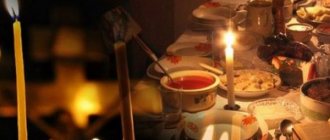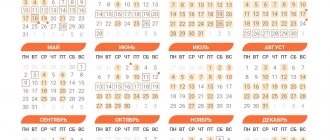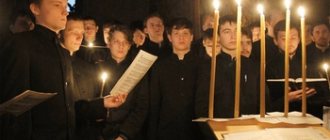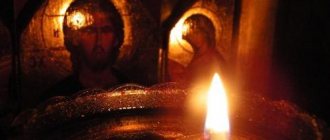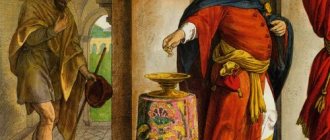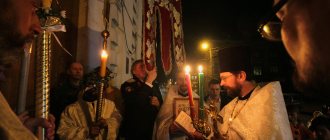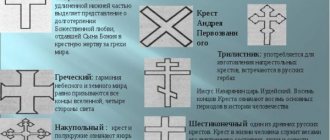Photo: AP Archive
— How long does Lent last?
— Lent lasts seven weeks (48 days) and is divided into four parts: Lent (forty days), Lazarus Saturday (one day), Entry of the Lord into Jerusalem (one day) and Holy Week (six days). These days begin with Forgiveness Sunday (this year on March 14) and end with the day of the Resurrection of Christ - Easter on May 2.
— Many people, especially women, fast with the sole goal of losing weight.
- Don't confuse fasting with hunger strike. The period of Lent and Easter is the brightest period of time in the Orthodox calendar. This is a time of spiritual and physical achievement. We need to read prayers, try to attend divine services more often, do good deeds and strive to live according to God’s commandments.
—What else should believers do during Lent?
—Lent is a time to analyze your spiritual life. Consider your view on all the issues that are posed to a person every day: in school, in work and in family life. Many people confess and receive communion during Lent.
— If we talk about food, what foods are prohibited?
- Animal origin. We must observe the rule of fasting, but fulfilling the rule of fasting depends on our physical and spiritual strength. We cannot take on what we cannot do. During fasting, relief is given to children, pregnant women, nursing mothers, travelers, and the sick.
— What if an ordinary person cannot maintain a strict diet?
— If you don’t succeed in strictly observing the fast the first time, there is no need to worry, because a person must fast to the best of his ability. Some are fasting for the first time, while others already have spiritual experience. Therefore, throughout the year, a person prepares for Lent, observing one-day fasts every Wednesday and Friday, Epiphany Eve (Epiphany Eve), the Beheading of John the Baptist, and the Exaltation of the Cross of the Lord. As well as multi-day fasts - Petrov, Uspensky and Christmas fasts.
Lent is one of the strictest fasts in the church calendar. The clergy remind us that this is not only abstinence from certain foods, but also from alcohol, any entertainment and profanity.
- During the first and last weeks of Lent, a particularly strict fast is observed.
- Meat and dairy products (butter, cheese, cottage cheese, milk), eggs, are excluded. That is, all products of animal origin.
- You can eat only once a day, in the evening, but on Saturdays and Sundays you are allowed to eat twice a day, at lunch and in the evening.
- On Monday, Wednesday and Friday, eat cold food, without vegetable oil. On Tuesdays and Fridays, hot food without oil is allowed.
- On Saturdays and Sundays it is allowed to add vegetable oil to food, and it is also allowed to drink grape wine (except for Saturday of Holy Week).
- On Good Friday (this is the last Friday of Lent) you should abstain from food altogether.
- On Saturday, many fasters also abstain from food until the onset of Great Easter.
Age category of materials: 18+
- Arina Alexandrova
What date is Lent in 2022?
The start and end dates of fasting are different every year. They depend on the date of Easter. The duration of Lent is 48 days. It begins on Monday, seven weeks before Easter and ends on Saturday, before this great holiday. In 2022 it lasts from March 7 to April 23 (inclusive).
It consists of two parts - Holy Pentecost (first 6 weeks) and Holy Week (last week - 6 days).
Each week of Lent has its own name and symbolic meaning.
Week 1 – Triumph of Orthodoxy
This week Orthodoxy honors the victory in iconoclasm. Particular respect is paid to Empress Theodora of Constantinople, who restored the veneration of icons in the church after being banned in the 8th century.
Week 2 – St. Gregory Palamas
The Church reveres this saint for his teaching and victory in theological disputes. He explained the connection between God and the world.
Week 3 – Worship of the Cross
During this period of Lent the Cross is venerated.
Week 4 – St. John Climacus
This saint is presented to all Christians as an example of fasting and spiritual life.
Week 5 – Venerable Mary of Egypt
This saint is revered because she was able to get rid of a depraved life through intense fasting.
Week 6 – Entry of the Lord into Jerusalem, Vai week
The name comes from the word “vay” - palm leaves that were used to cover the path of Christ before entering the city of Jerusalem. In Slavic countries, an alternative to palm branches is willow branches.
Week 7 – Holy Week
This week we remember the last days of the earthly life, suffering, death and burial of Jesus Christ.
Maslenitsa, the meaning of every day
Maslenitsa is the most cheerful and satisfying folk holiday. People affectionately called him “killer whale”, “sugar mouth”, “kisser”, “honest Maslenitsa”, “cheerful”, “quail”, “overbooty”, “overeating”, “yasochka”. The main treat, of course, was pancakes, which were baked in huge quantities. It was believed that if you don’t have fun on Maslenitsa, you can live the coming year poorly and joylessly.
Monday, February 28. "Meeting of Maslenitsa." On this day they started baking pancakes. The first was given to the poor and needy. On the first day, they prepared the scarecrow, dressed it in rags and displayed it on the main street until Sunday.
Tuesday, March 1st. "Flirting." On this day, young people organized folk festivals, sleigh rides, ice slides, and carousels.
Wednesday, March 2. "Gourmand." On this day, guests (friends, relatives, neighbors) were invited to the house. They were treated to pancakes, honey gingerbread and pies. Also on Wednesday, mothers-in-law fed beans to their sons-in-law. On this day, horse racing and fist fights were held.
Thursday, March 3. "Go for a walk." From this day begins Broad Maslenitsa, which is accompanied by snowball fights, sledding, cheerful round dances and chants.
Friday, March 4th. "Mother-in-law's evening." On this day, the sons-in-law invited the mother-in-law to their house and treated her to delicious pancakes.
Saturday, March 5th. "Sister-in-law's get-togethers." Daughters-in-law invited their husband's sisters to their house, talked to them, fed them pancakes and gave them gifts.
Sunday, March 6th. "Forgiveness Sunday". On Sunday we said goodbye to winter and said goodbye to Maslenitsa by burning an effigy. On this day, you need to ask your friends and family for forgiveness for the grievances that have accumulated over the year.
What you can and cannot do on Maslenitsa
On Maslenitsa it is forbidden to eat meat. You can eat fish and dairy products. The main dish these days are pancakes. You are allowed to eat often and a lot on Maslenitsa. You definitely need to invite guests home, and also go to visit yourself. During Maslenitsa week you cannot swear, get angry or use foul language. There should be an atmosphere of fun and friendliness around. On the first day of Maslenitsa, in order to attract good luck, it is forbidden to be sad. During Maslenitsa, you should not welcome guests in a dirty, untidy house. Cleaning the house can only be done on Narrow Maslenitsa, that is, on the first three days of the holiday week. Cutting pancakes with a knife was not allowed: it was believed that using sharp objects could cause trouble.
What can you eat during Lent: nutritional rules
Lent is the strictest. The main food products during this period are pickles and preserves of vegetables and fruits, onions, carrots, cabbage, beets, legumes, apples, oranges, nuts, and dried fruits.
The first week they adhere to a particularly strict fast. On the first day (Clean Monday) you must completely abstain from eating. Then, from Tuesday to Friday, you can eat bread, salt, raw fruits and vegetables, dried fruits, nuts, honey, drink water (dry eating is allowed), and on Saturday and Sunday - hot food with butter.
In the second to sixth weeks of fasting, dry eating is prescribed on Monday, Wednesday and Friday, hot food without oil on Tuesday and Thursday, and hot food with butter on Saturday and Sunday.
During Holy Week they adhere to strict fasting. On all days of this week, dry eating is allowed, and on Friday you cannot eat food until the shroud is taken out.
On the church holiday of the Annunciation of the Blessed Virgin Mary (April 7) (if it does not fall on Holy Week) and on Palm Sunday (7 days before Easter) you can eat fish. On Lazarus Saturday (before Palm Sunday) it is allowed to eat fish caviar.
According to the monastic Charter, the above rules are mandatory for observance among monks. Laymen do not have to adhere to the strictness of fasting. Parishioners coordinate the nutrition calendar with spiritual mentors, taking into account all life circumstances, health conditions and body characteristics.
The article provides a calendar of the monastic Rules, which gives an idea of the degree of severity of fasting by day. Each person individually, together with his confessor, determines the degree of severity of his fast.
Who is allowed not to fast?
For physiological, medical and age-related reasons, it is better for children, the elderly, pregnant and lactating women, people with metabolic disorders, people with diabetes, people with digestive diseases, cancer patients, those suffering from kidney dysfunction, undergoing post-operative rehabilitation, people with chronic diseases and acute respiratory infections.
Annunciation of the Blessed Virgin Mary
The Annunciation of the Blessed Virgin Mary is the twelfth Orthodox holiday, which is celebrated annually on April 7 (March 25, old style) and is exactly 9 months from the date of the celebration of the Nativity of Christ. The holiday was established in remembrance of the announcement to the Virgin Mary by the Archangel Gabriel of the good news of the conception and birth of the Divine Child Jesus Christ. The Annunciation has one day of pre-celebration and one day of post-celebration, on which the Council of St. Archangel Gabriel.
Annunciation of the Blessed Virgin Mary. Holiday event
The Most Holy Theotokos was raised at the church, where she was brought by her parents at the age of three. Upon reaching the age of 14, she could no longer live at the temple; she should have gotten married, since her parents had died by that time. Tradition says that the high priest knew about the vow given by the Blessed Virgin to preserve virginity. Therefore, he decided to betroth Her to a pious man who would be Her guardian.
The staves of 12 pious elders from the family of David were left in the temple overnight. The next morning the high priest saw that the rod of Joseph, the carpenter from Nazareth, had blossomed. He was a widower with grown children, four sons and two daughters. Obeying God's will, Joseph became the Betrothed of the Blessed Virgin. We learn about the Annunciation in the Gospel of Luke:
After these days Elizabeth his wife conceived, and hid herself for five months and said: Thus did the Lord do for me in these days, in which he looked upon me, to remove from me the reproach of men. In the sixth month the Angel Gabriel was sent from God to the city of Galilee, called Nazareth, to a Virgin betrothed to a husband named Joseph, from the house of David; The name of the Virgin is: Mary. The angel, coming to Her, said: Rejoice, full of grace! The Lord is with You; Blessed are You among women. She, seeing him, was embarrassed by his words and wondered what kind of greeting this would be. And the Angel said to Her: Do not be afraid, Mary, for You have found favor with God; and behold, you will conceive in your womb and give birth to a Son, and you will call His name Jesus. He will be great and will be called the Son of the Most High, and the Lord God will give Him the throne of His father David; and He will reign over the house of Jacob forever, and His kingdom will have no end. Mary said to the Angel: How will this be when I don’t know my husband? The angel answered Her: The Holy Spirit will come upon You, and the power of the Most High will overshadow You; therefore the Holy One who is to be born will be called the Son of God. Here is Elizabeth, Your relative, who is called barren, and she conceived a son in her old age, and she is already in her sixth month, for with God no word will remain powerless. Then Mary said: Behold, the Servant of the Lord; let it be done to me according to your word. And the Angel departed from Her. (Luke 1:24-38).
Church tradition says that immediately before the Annunciation, the Blessed Virgin read the book of the prophet Isaiah, which says:
Behold, the Virgin will conceive and give birth to a Son, and they will call His name Immanuel (Isa. 7:14).
So great was the humility of the Blessed Virgin that she wished to be at least the last servant for the One who would be chosen by God. At this moment, when She was ready with all her heart to serve the mystery of the Incarnation, Archangel Gabriel appeared to her with good news.
How to prepare and enter into fasting as planned
- It is better to start preparing for fasting a couple of weeks in advance. It is necessary to gradually reduce the content of animal products in the diet and increase the amount of plant foods.
- In the last week before fasting, it is necessary to create a protein depot so that the body does not experience shortages. Nutritionists recommend eating an egg and 150-200 grams of fish daily. It is better to exclude animal meat, as it is less easily absorbed by the body.
- It is necessary to accustom the body to fiber. The main diet of lean food is vegetables and fruits, which contain large quantities of fiber. Add fresh salads and snacks of vegetables and fruits to your diet every day. Oil week can help with this if you add bran or wholemeal flour to the dough for baking pancakes.
- Restore intestinal microflora. In order not to experience discomfort after changing your diet, you need to take care of your intestines - populating it with beneficial bacteria. To do this, a week before fasting, it is recommended to consume fermented milk products every day: yogurt, kefir, yogurt. These products can be prepared independently using a starter made from bifidobacteria.
- In the first days of fasting, it is recommended to increase portions and the number of meals. Lenten dishes are lower in calories. This will prevent you from feeling hungry.
- Snack on vegetables and fruits to keep you full throughout the day.
Preparatory period for Lent
Includes 3 weeks and 4 weeks.
Lent Stairs
- Week of the Publican and the Pharisee ( Luke 18:10–14) – February 13.
- The week is “continuous” (no fasting on Wednesday and Friday) (February 19).
- Sunday of the Prodigal Son (Luke 15:11–32) – February 20.
- Ecumenical parental (meat-free) Saturday – February 26.
- Meat Week ( the last
- Cheese week (Maslenitsa), “continuous” (February 28 – March 5).
- It's a raw week . Memories of Adam's exile. Forgiveness Sunday (Matt. 6:14–21) – March 6.
***
Bright Resurrection of Christ. Easter – April 24
Bright Week, continuous (April 30).
Weeks after Easter
- Antipascha ( lit. “ Instead of Easter”) otherwise – 2nd Sunday John 20:19-31) – May 1. Radonitsa (Easter commemoration of the dead) – May 3, Tuesday.
- 3rd Sunday after Easter, the Holy Myrrh-Bearing Women ( that and the memory of the righteous Nicodemus and Joseph of Arimathea, secret disciples of Christ (Mark 15:43–16:8) - May 8.
- 4th Sunday of Easter, about the paralytic ( John 5 Midnight of Pentecost (John 7:14-30) – May 18, Wednesday.
- 5th week of Easter, about the Samaritan woman ( John 4:5-42) – May 22.
- 6th Sunday of Easter, about the blind man (John 9:1-38) – May 29.
- ASCENSION OF THE LORD ( Acts 1:1-12; Luke 24:36-53) – June 2.
- 7th week of Easter, Holy Fathers of the First Ecumenical Council - June 5. Trinity Parents' Saturday (commemoration of the departed) - June 11.
- Week 8 of Easter. HOLY TRINITY DAY (Pentecost) (Acts 2:1-11; John 7:37-52; 8:12) – June 12. 1st Week after Pentecost, continuous (June 18). Holy Spirit Day (“Spirit Day”) – June 13, Monday.
- 1st Sunday after Pentecost - Feast This holiday ends the Triode (moving) cycle itself; its unique continuation became in the Russian tradition the holiday in honor of all Russian saints (established at the Local Council of 1917–18). At the end of the 20th century, holidays began to appear in honor of regional – first Vologda, and then other – saints.
